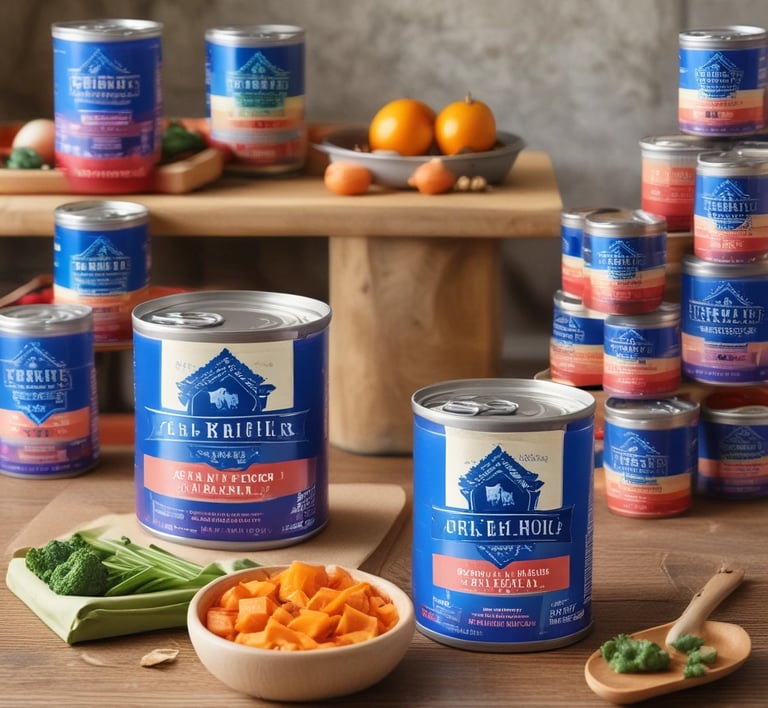Get 20% off your first order!
Top 5 Best Dog Food in the USA: A Complete Guide for Pet Owners
As a pet owner, you the best for your four-legged friend, that often starts with food. With so many options available on the market, navigating through dog food brands can be overwhelming. Which ones are truly the best for your pup? In this comprehensive guide, we’ll explore the top five dog food brands in the USA, diving into their ingredients, nutritional benefits, and what makes each stand out. Let’s help you find a tail-wagging solution for your furry companion!
6/3/20256 min read


Understanding Your Dog's Nutritional Needs
Providing a balanced diet is crucial for maintaining the health and well-being of dogs. Just like humans, dogs require a variety of essential nutrients to support their bodily functions and overall health. Key components include proteins, fats, carbohydrates, vitamins, and minerals, each serving a unique purpose in a dog's diet.
Proteins are fundamental as they are the building blocks of your dog's body, playing a significant role in muscle development, immune function, and the production of enzymes and hormones. High-quality protein sources such as meat, fish, and eggs should be included in any dog food recipe to ensure adequate amino acid intake. They are particularly vital for growing puppies and active dogs who have higher protein requirements compared to sedentary adults.
Fats are another essential dietary component, providing energy and supporting healthy skin and coat. Omega-3 and Omega-6 fatty acids are particularly important as they help reduce inflammation and promote heart health. It’s crucial, however, to ensure that the sources of fat in your dog’s food are healthy and beneficial.
Carbohydrates contribute to sustained energy and aid digestion. While dogs do not rely heavily on carbohydrates as their primary energy source, including fiber-rich grains and vegetables can help maintain digestive health and stabilize blood glucose levels. This is especially true for older or less active dogs, who may require fewer carbohydrates due to decreased energy expenditure.
Vitamins and minerals support various bodily functions, including bone health, immune response, and skin health. A complete and balanced dog food will usually provide all necessary vitamins and minerals, but pet owners should always verify labels for adequacy in these essential nutrients.
Finally, it is important to consider a dog's age, size, and activity level when assessing nutritional needs. Puppies require more protein and calories for growth, while senior dogs often need special formulas that focus on joint health and digestion. Tailoring your dog’s diet to their specific needs can make a significant difference in their health and longevity.
Factors to Consider When Choosing Dog Food
When selecting the best dog food for your canine companion, several critical factors must be taken into account to ensure optimal health and well-being. One of the foremost considerations is the sourcing of ingredients. High-quality dog food brands tend to prioritize the use of whole foods, such as whole meats and fresh vegetables, rather than relying on meat by-products, which may include less desirable parts of animals. This distinction can significantly impact your dog's nutritional intake, so examining the ingredient list closely is essential.
Another important aspect to consider is the presence of artificial additives. Some dog foods contain preservatives, colorings, and flavor enhancers that can be harmful to dogs. Opting for brands that use natural preservatives and avoid synthetic chemicals can enhance your pet's health. Being informed about these additives allows dog owners to make educated choices that favor their pet's long-term wellness.
Understanding how to read dog food labels is critical in selecting an appropriate diet for your dog. Dog food labeling regulations often outline the nutritional value, ingredient sources, and feeding guidelines. Knowing how to interpret these labels will assist you in selecting food that matches your pet's dietary needs and preferences. Furthermore, pet owners should be conscious of the various types of dog food available: dry, wet, and raw diets. Dry food is generally cost-effective and convenient, while wet food may be more palatable for picky eaters and can contribute to hydration. Raw food diets, while increasingly popular, require careful handling and knowledge about balanced nutrition.
Ultimately, taking these factors into account will help ensure that you select the right dog food, catering to your pet's unique health requirements and dietary preferences. Making informed decisions will support your dog's health and happiness for years to come.
Top 5 Dog Food Brands in the USA
When it comes to selecting the right dog food, several brands have gained recognition for their quality ingredients, nutritional value, and overall popularity among pet owners in the USA. Here, we explore five of the top dog food brands, taking into account various factors such as ingredient quality, customer feedback, and the specific needs of different dog breeds.
1. Blue Buffalo is known for producing high-quality, natural pet foods which are rich in proteins and made with real meat as the primary ingredient. They offer various lines such as the Life Protection formula, which includes whole grains and is designed for dogs at all life stages. Their emphasis on using high-quality ingredients free from artificial preservatives and fillers enhances their popularity.
2. Royal Canin stands out with its breed-specific formulas tailored to various canine needs. Each recipe considers a dog's specific breed, age, and size. The brand is particularly known for its focus on veterinary diets, making it a preferred choice for pets with health issues requiring special nutrition. These specialized recipes ensure that each dog receives the precise nutrients necessary for optimal well-being.
3. Wellness Pet Food promotes holistic pet nutrition, offering grain-free and high-protein options. Their core recipes focus on premium meats and are free from artificial additives. This brand appeals to health-conscious pet owners looking for a balanced diet that supports their dogs’ overall vitality and well-being.
4. Orijen emphasizes biologically appropriate diets with a focus on high-quality regional ingredients. Known for their grain-free and protein-rich formulas, Orijen is crafted to mimic a dog’s natural diet, ensuring they receive essential nutrients derived mainly from animal sources. This brand is particularly appealing to owners seeking to provide their dogs with a diet that aligns with their evolutionary needs.
5. Nutro rounds out the list with its commitment to clean and simple ingredients, including real meat and garden-fresh vegetables. Nutro’s recipes are designed to cater to different life stages and sensitivities, making them suitable for diverse dietary needs. Their focus on transparency resonates with pet owners who prioritize understanding what goes into their pet's food.
These top dog food brands in the USA have established trust and loyalty among pet owners, thanks to their commitment to quality and health. Choosing the right food for your dog can significantly impact their overall health and happiness, making knowledge about these brands essential for any conscientious pet owner.
How to Transition Your Dog to a New Food
Transitioning your dog to a new food is an important process that should be undertaken with care. A sudden change in diet can lead to digestive issues such as vomit, diarrhea, or even refusal to eat. Therefore, it is essential to gradually introduce the new food to your dog. This method helps their digestive system adjust to the new ingredients while minimizing potential discomfort.
The recommended timeframe for transitioning is typically around 7 to 10 days. Begin by mixing a small amount of the new dog food with the current diet. For the first few days, you might consider using approximately 25% new food and 75% old food. As your dog begins to acclimate, gradually increase the proportion of the new food while decreasing the old food. By the end of the transition period, you should aim for a full switch to the new diet. This slow introduction allows your dog's digestive system time to adapt to the new nutritional profile and flavors, making it easier for them to accept the change.
While transitioning, it is crucial to monitor your dog’s behavior and appetite closely. Look for signs that indicate whether your dog is adjusting well or experiencing issues. If your dog shows a decreased appetite or exhibits any gastrointestinal distress, consider slowing down the transition and giving them a bit more time with the old food mixed in. It may also be helpful to engage your dog with positive reinforcement, such as praise or treats, when they show interest in the new food. Making mealtime enjoyable can encourage a smooth transition to the new diet. Always consult your veterinarian if there are concerns about your dog’s health during this process, as they can provide tailored advice suited to your pet’s specific needs.






PETURACARE
Your one-stop shop for pet wellness products.
Connect
Support
+1-891-833-7300
© 2025. Peturacare All rights reserved.
